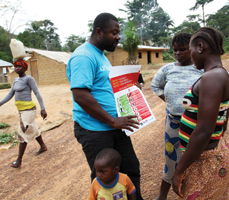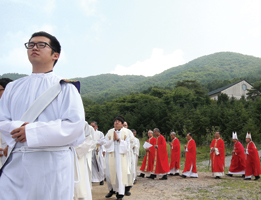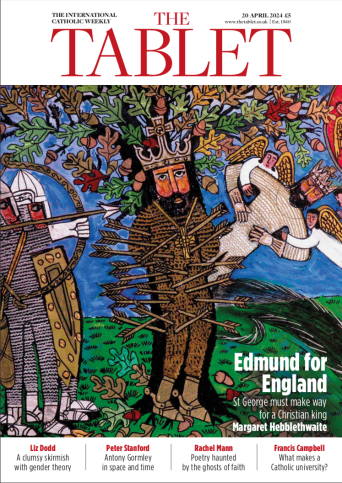On Thursday, Pope Francis begins a five-day visit to South Korea, a country with a young and growing Catholic community. He will beatify more than 100 Korean martyrs, a reminder of the persecution of Christians that is continuing in North Korea
When Pope Francis touches down in Asia next week, home of half the world, he will arrive in an unusual place, a choice so unexpected as to be inspired, at least with a little bit of the new papal way of looking at things.
He will not follow in the footsteps of Matteo Ricci SJ, who brought modern mathematics and cartography to China, today the world’s largest country and booming potential megapower, which has more than 100 million suffering Christians, 12 to 15 million of them Catholic. He has not chosen India, where the other sainted Francis – Xavier SJ – lies buried after a life in the Asian mission fields and where there are 17 million Catholics. He will not go to Japan, where Xavier and other missionaries had success until the shoguns cracked down and martyred hundreds of Catholics.
Instead, Pope Francis will arrive in the Republic of Korea, as South Korea is officially known, where Catholics comprise 11 per cent of the 51 million-strong population, although a growing influence. The greater significance is that he is attending Asian Youth Day and will be in a place that will give him both a challenge and an opportunity to make his voice heard far beyond Korea and the region.
Modern Korea was formed in the cruel crucible of war, which is still potentially tragically alive. As Professor Rana Mitter of Oxford University reveals in his masterly book, China’s War with Japan, 1937-1945: the struggle for survival, the Second World War really began in 1937 with Japan’s full-scale invasion of China. In a wider sense, the struggle started when Meiji Japan (the period from 1868 to 1912) successfully copied Western industrialisation, and its political and military leaders wanted their own empire to help feed the growing economy.
Korea suffered as a Japanese colony from 1910 to 1945, and was then split in two as China and Russia on the one side and the United States and its allies on the other offered a prelude to the Cold War with a nasty hot one. The peace finally reached in 1953 was not a true peace, but an armistice.
South Korea is a fascinating study. The people are far different from their Japanese cousins across the sea, less bureaucratically driven, more open and volatile. Some people say jokingly that Koreans are the Irish of Asia, hot-tempered, though that might be an overexcited reaction to too much hard liquor and kimchi, the fiery garlic-chilli cabbage dish that is a hallmark of Korean cuisine. Others claim that if the Earth were flat, Korea would be the place where you jumped off the edge.
At the start of the 1960s, Korea seemed a hopeless case, impoverished by Japanese colonialism and a war that left most of the raw materials in Communist North Korea. With few resources except the dictatorial government planning of Park Chung-hee, the entrepreneurial ideas of big business groups and hard work of its people, Korea grew into an economic powerhouse. Per capita income grew from US$100 (worth around $800 or £475 today when adjusted for inflation) in 1960 to $32,000 (£19,000) in 2014, with Korea now the fifteenth biggest economy in the world or the twelfth according to purchasing power parity exchange rates.
Unusually, Catholicism did not come to Korea through priests but was inspired by laypeople, who brought books by Ricci from China. One of Korea’s first Catholic martyrs, Yi Seung-hun, was baptised in China in 1784, taking the name Peter, and returned home to inspire other Koreans to be baptised. The first, French, missionary priests did not arrive in Korea until 1836.
The ruling dynasty denounced Catholicism as “evil” because it was opposed to Confucian practices including ancestor worship. Through the eighteenth and nineteenth centuries Catholics faced persecution. An initial 103 martyrs were canonised by Pope John Paul II in 1984, and Pope Francis will preside over the beatification of another 124 Koreans killed in those persecutions.
In the second half of the twentieth century, Protestantism grew rapidly, Catholicism more slowly, with the hillsides of Seoul illuminated at night with hundreds of crosses marking Christian churches. Catholicism began to grow faster with the Church’s role in the coming of democracy to Korea, which was run by a series of military dictatorships from the 1960s until the late 1980s. The number of Catholics has increased by 70 per cent in the last decade, although Protestants outnumber Catholics and are about 19 per cent of the population.
Cardinal Stephen Kim Sou-hwan (1922-2009) offered quiet diplomacy with the military rulers reinforced by prophetic warnings about the “long dark tunnel” of military dictatorship. He told one leader: “I feel like we’re watching a Western cowboy movie: whoever grabs the gun first wins the game.”
In the 1987 protests, the cathedral on the small hill of Myeongdong in Seoul, then a shabby area of local shops, became a safe haven for students protesting for democracy. Kim told the military that they would have to overcome him and the priests and nuns to get to the students.
While not downplaying Cardinal Kim’s role in the democratic movement, Jesuit professor Fr Dennis McNamara, who teaches at Georgetown University, Washington DC, and at Sogang University in Seoul, notes that “the Catholic Farmers’ group in rural areas was perhaps the real core of the [democracy] movement”.
Today, South Korea faces problems of roaring economic success. The approach to Myeongdong Cathedral is now a brightly lit landmark leading to glitzy shopping and nightlife. Corruption has been uncovered among the “chaebol”, the powerful industrial groups. Bishop Peter Kang U-il, president of the Catholic Bishops’ Conference of Korea, warned that the country “is struggling with the conflicts surfacing from increased social polarisation” of economic success.
The Pope also risks being sucked into controversy, and has been criticised for plans to meet the elected but autocratic President Park Geun-hye in her office. She is the daughter of assassinated dictator Park Chung-hee. She was baptised as a Catholic when at Sogang, but today practises no religion. Columban missionary Fr Pat Cunningham warned that the Pope’s visit “could be exploited for political gain by a government desperate to rescue some semblance of legitimacy”.
Another Columban, Fr Noel O’Neill, criticised the planned visit to Kkottongnae (Flower Village), a Catholic-run facility for disabled people, which houses 2,000 residents and is run on an “eighteenth-century model” according to O’Neill.
But the Pope’s first Asian visit is not only about South Korea and the martyrs of past centuries. He is going to a divided land, where North Korea is ruled by an unpredictable dynastic dictatorship that brandishes the threat of nuclear weapons while its people suffer all sorts of basic deprivations. Cardinal Andrew Yeom Soo-jung, the Archbishop of Seoul, said Koreans are hoping for a “miracle” for the peninsula. Professor McNamara listed “peaceful reconciliation” with North Korea as one focus of the message Pope Francis will deliver. Organisers are still waiting to hear whether a token number of Catholics from the North will be allowed to go to South Korea.
Francis’ challenge goes far beyond the Korean peninsula. The wider Asian region is an area of immense economic growth and of rising tension as China flexes its muscles and challenges the prevailing Pax Americana. Under President Xi Jinping, China’s ruling Communists seem hell-bent on another anti-Christian wave. But the excited supporters of the Pope have to recognise that Catholics are a mere 3 per cent of Asia’s population. If they are honest, they will admit that few Asians are interested in the Catholic Church. This is a region where keeping up with the Kims, Lis, Nakamuras and Nguyens is the most important factor with, at state level, the growing fears about China’s imperial reach.
However, in key areas, especially education and medicine, schools, universities and hospitals, from India and Thailand to Hong Kong and Japan, the Catholic Church offers learning and healing that is respected Asia-wide. Then there is the unique standing of the Pope himself. Soviet dictator Joseph Stalin famously asked how many divisions the Pope commanded. But when the Pope speaks, the world listens, at least for a short while.
Pope Francis has already established a reputation for offering an authentically different message of peace. You can be sure that China’s Xi and North Korea’s Kim Jong-un will be listening as Francis speaks in Korea: what will be his message of hope and peace for a prosperous but troubled Asia?
Kevin Rafferty is a long-established journalist and commentator on Asia.
07 August 2014, The Tablet
Shepherd of Seoul
Edmund for England
 Loading ...
Loading ...
Get Instant Access
Subscribe to The Tablet for just £7.99
Subscribe today to take advantage of our introductory offers and enjoy 30 days' access for just £7.99





What do you think?
You can post as a subscriber user...
User Comments (0)